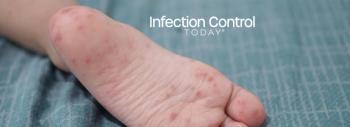
How to Choose the Right Disinfectant to Prevent Health Care-Associated Infections
Choosing the correct disinfectant can be difficult. This expert explains how to select the proper one.
According to the
Disinfection of dirty, soiled surfaces is not achievable, so a precleaning step is often required before applying the disinfectant. In some cases, the EPA allows products to claim that they can “clean and disinfect in a single application,” provided the surface is visibly clean. Products that can clean and disinfect in 1 application will be labeled as such. Disinfection of Clostridiodies difficile, candida auris, biofilm, and Occupational Safety and Health Administration (OSHA) bloodborne pathogens requires surfaces to be precleaned. Crucial to infection control and prevention in hospitals and other health care facilities is choosing the proper disinfectant to kill bacteria, fungi, and inactivated viruses that cause pHAIs.
Over 10,000
Given the sheer volume available, choosing the proper disinfectant might seem daunting. With the following guidelines, infection preventionists, environmental services (EVS), and hospital facilities managers can ensure they use the appropriate disinfectant to optimize infection prevention and control in their health care facilities.
- Start with the EPA lists.
Start with the
- Read the instructions
Every EPA-registered product has an EPA
Start by ensuring the disinfectant addresses the organisms of concern (eg, C difficile, MRSA, Candida auris, biofilm, norovirus, etc). If it is not listed on the master label, the disinfectant is ineffective against that particular pathogen. Then, look at dwell time, determining how long the surface must stay wet to kill the specific pathogen. Make sure that the dwell time is achievable. Next, review the directions for applying the disinfectant. For example, some products stipulate they must be used only via a spray versus a wipe–if wiped, the disinfectant is ineffective. Finally, ensure the disinfectant meets your operational policies and procedures for infection prevention. For example, a spray disinfectant should not be used when a patient is in the room.
- Ensure it is Broad-Spectrum
You won’t always know what organisms you’re contending with, especially in a health care setting, where you’ll likely deal with many. Broad-Spectrum means it kills various bacteria, viruses, and fungi, including the harder-to-kill species. Ideally, you’ll identify 1 product that handles all pathogens, including C auris, C difficile, MRSA, and biofilm.
- Ensure the chemistry is effective against biofilm
More than
- Review safety warnings
Understand that disinfectants are hazardous by definition–they’re designed to kill. However, some are more hazardous than others.
In health care facilities, you’re dealing with ill people, so you want to choose safe products. Many disinfectants, particularly legacy products, are highly hazardous to the people applying them, the patients, and the staff. Look for the least hazardous disinfectant with the highest efficacy. Find a disinfectant with a safe pH range to ensure it is not hazardous to skin, lungs, or eyes. Ensure the product is non-carcinogenic.
Start with the product’s Hazardous Material Identification System (HMIS) rating, which is a scale of zero (safest) to four (most hazardous). The HMIS rating will have 3 numbers associated with health, fire, and instability risk. The ideal product will have an HMIS of 0/0/0, although many disinfectants are eye irritants, indicating an HMIS of 1/0/0. If you use a disinfectant delivered in concentrate form for dilution on site, evaluate the HMIS of both the concentrate and diluted products.
- Choose 1 disinfectant
Historically, health care disinfection meant using 1 product for most tasks and then switching to more hazardous chemicals for other, more difficult pathogens (eg, C difficile). This meant more training of staff and an increased chance that something could go wrong, such as mixing incompatible chemicals. Today, safer, broad-spectrum products are available. If you pick the proper disinfectant, you should need only 1 product throughout your health care facility. With 1 effective broad-spectrum disinfectant, infection preventionists, EVS directors, and health care facility managers can decrease the training required and significantly reduce pHAIs, risk, and costs.
- Consider environmental implications
Look at the environmental impact of your disinfectant. For example, are you paying to ship water? Many ready-to-use (RTU) disinfectants are 99% water and packaged in individual plastic bottles that end up in landfills. The implications are higher shipping, packaging, and storage costs, resulting in a significant carbon footprint.
What are you going to do with unused disinfectant products? Some highly acidic (low pH) disinfectants cannot be disposed of down the drain and sewer system. Some highly caustic (high pH) products can damage sewer lines. Concentrated, safer disinfectants will cut shipping and storage costs while reducing your environmental footprint via less packaging, more efficient shipping, and safer disposal.
Another consideration is the selected disinfectant's impact on medical equipment, mattresses, furniture, and floor finishes. Disinfectants with low pH (acidic) and higher pH (alkaline) can cause severe damage, resulting in significant replacement costs.
- Don’t forget about training!
In addition to choosing the proper EPA-registered disinfectant, regular training of hygiene specialists and other EVS staff is critical for appropriate cleaning and disinfection. Ensure all staff members understand why a particular disinfectant was chosen. Explain the importance of following all instructions on the master label, including proper use, dwell time, and key safety precautions. Doing so will ensure that EVS staff use the disinfectant safely and per the EPA master label instructions. By providing all staff understanding of best practice protocols and processes, health care facilities can eliminate the risk of cross-contamination and decrease pHAIs.
The proper disinfectant plays a key role in reducing the cost and burden of pHAIs on all types of health care facilities and society. When selecting the best disinfectant for your health care facility, follow the above criteria to help ensure a safe and hygienic environment for patients and staff.
Newsletter
Stay prepared and protected with Infection Control Today's newsletter, delivering essential updates, best practices, and expert insights for infection preventionists.






